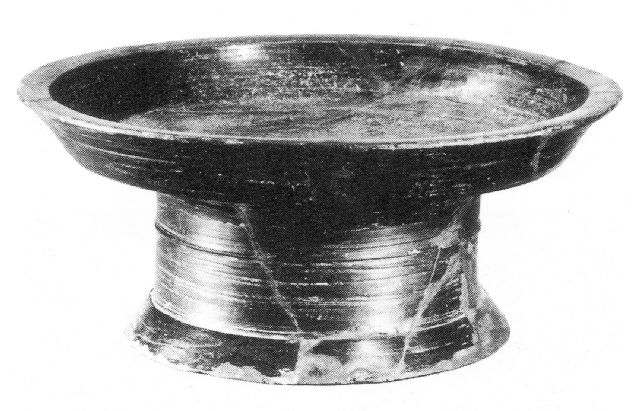SHANG (16th - 11th cent. B.C.E.)
The Bronze Age contained
the Shang and Zhou dynasties. The former, primarily in modern day
Henan, Hebei and Shandong provinces, is the first completely scientifically
verifiable Chinese dynasty, alternately dated 1766-1122
B.C.E. (The earliest dated bronze object in China, however, a knife cast from a mold found in
Gansu Province -- to the west and northwest of Xian -- is from about 3000 B.C.E..
It is believed that the high temperatures of the Neolithic kilns used to fire pottery were hot enough to melt metals
from stone. Pottery kilns found near Xian could maintain temperatures at 1400°C as early as the 6th millennium
B.C.E., more than enough to melt copper. For this reason, scholars believe Chinese artisans
were able to develop bronze without the influence of other cultures.)
Now, with the production
of bronze -- an alloy of copper and tin, or copper and certain other metals
-- life took on more sophistication. Tin-copper bronzes were 14
to 20% tin; tin-copper-lead bronzes were 1 to 18% lead; copper-lead
bronzes could be 30% or more lead. These latter seem to be more
prominent in burial caches: perhaps cheaper lead was substituted for
tin in bronzes, whether weapons or vessels, destined merely to be
buried. (In the course of time many of these bronzes --
originally somewhat shiny, moderate yellowish-brown -- have acquired a
beautiful patina, much valued by connoisseurs, which ranges from
malachite green and kingfisher blue to yellow or even red, according to
the composition of the metal and the conditions under which the vessel
was buried. The bronze may have come into contact with water, oxygen, carbon dioxide gas, sulfides,
salts and microbes in the soil. Long-term chemical and biological reactions, along with foreign elements
penetrating into the metal alloy, can easily cause corrosion. Forgers have gone to enormous trouble to imitate
these effects. Copies can sometimes be discovered by metallurgical analysis which shows an uncharacteristic
blend of metals for the claimed period of origin.)
Bronze shapes were often originally derived from older pottery forms,
and then the form and ornamentation of later superior ceramic wares became derived from those ritual and utilitarian
bronze vessels which were their contemporaries. It is quite possible that the kilns used for bronze
production were sometimes simultaneously employed for hard-firing ceramics, if for no other reason than the best
use of the supply of fuel wood. The Shang pottery industry was highly advanced; they could easily
reach the high sustained temperatures that made smelting and casting relatively easy. (Also, many centuries later in post-Han
times, a notable effort would be made to reproduce the detail of ornate bronze basins in the new green celadon ware,
one of whose attractions was its resemblance to the patinated surface of bronzes recovered from ancient
tombs or preserved in palace treasuries. Other pottery vessels from the Han dynasty were lead-glazed in green
or brown, both of these colors giving a fair imitation of patinated bronzes as well.)
Bronze vessels made possible
more civilized ways and means of preparing food, and laid the foundation
for an elaborate system of etiquette and ceremonial rituals. These
became an important part of life for the ancient Shang rulers and aristocracy.
This metal was held in higher esteem than gold or silver. All the known major weapons had their cutting or piercing
parts made of bronze, and this gave the Shang superiority over neighboring kingdoms. Not surprisingly, the mining
of metals and the casting of molten bronze were industries tightly controlled by the Shang rulers. It was not widely
used for agricultural implements. Bronze vessels and weapons were among the symbolic gifts bestowed upon
a royal relative sent by the king to his own land to establish his own
town and political domain. When the provincial lineages became further
segmented, the bronzes were again a part of the gifts handed down the aristocratic
line. They were both associated with rituals for ancestor worship
and, as objects of precious materials that could only be acquired by those
in control of vast technological and political machinery, they were suitable
as symbols for sumptuary rule.
The large-scale
production of such technologically sophisticated bronzes must have required
multistage operations by many kinds of specialists, who must have been
organized and supervised by the state. The production of bronze --
from mining, ingot smelting, transportation to foundries and workshops,
guarding of the transportation routes, creation of the ceramic section-molds for casting, etc. -- depended on the presence
of a stratified social order with sufficient organization and force to generate and
replenish the required reservoir of forced labor. Bronze products,
hence, assumed the role of symbols of that order and then came to reinforce it.
These ritual bronzes, acting
as a kind of "collection plate," were made for the offerings of food and
wine to ancestral spirits which formed the core of the sacrificial rites.
Symbolizing the legitimacy of the aristocratic rule of chosen groups of
kin, the bronzes were then buried with nobles, whose spirits were assumed
to continue with the same sort of rituals after death. (Some scholars believe the latter Shang rulers
were weakened by the use of high-lead-content bronze drinking and cooking vessels.)
Pen
basins attributable to the Shang dynasty are rare, and they appear to belong to the end of the dynasty, specially
reserved for the use of the royal family.
The ring foot, a major advance in casting technology, was used to ensure that the core and the outer mould were
aligned properly. 2
|

